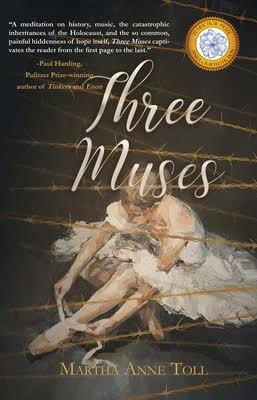
As my Jewish friends observed Rosh Hashanah this year, I finished reading Three Muses, an exquisitely crafted novel that weaves two worlds — the unimaginable horrors of the Holocaust and the excruciating beauty of professional ballet. In this debut novel, Martha Anne Toll dances with language (her lush descriptions and metaphors cast a spell) to resurrect the Holocaust in a way that seeps, drip by drip, into the reader’s bones before we have a chance to erect a protective wall of defense.
“Do you like reading Holocaust fiction?” my friend Liz, a writer and mom who was just about to begin observing the Jewish High Holy Days with her family, asked. I was about halfway through the book when she posed the question.
I paused. Looked off into the distance, remembering the main characters, Katya Symanova, John Curtin and Boris Yanakov (“Mr. Y”), who come to embody a physical triangle that reflects the title. The “three muses” are song, discipline and memory. “It’s more than Holocaust fiction,” I tell Liz. “It’s about ballet. It’s about love. And it’s about the impact of trauma over time, and how we can eventually break when we try to split off from that trauma without dealing with it.”
Early in the story — and with the intensity of a close and narrowly focused camera — we follow 11-year-old Janko Stein (who later becomes John Curtin) in Nazi-ruled Germany just as Nazi soldiers separate him from his family. His family is murdered while Janko (thanks to a last-minute move by his mother) is spared. She tells the soldiers that her son can sing for the concentration camp’s kommandant, and they whisk him away, keeping him, over the ensuing years, locked up in the kommandant’s home, where, frightened and often hungry, the boy is forced to sing for the Germans, unaware that they have murdered his family members and countless others, that the awful burning stench he’s smelled for years while toiling inside the Nazi’s house was the source of unimaginable horror.
The story weaves in and out of time periods — mostly the 1940s, ’50s and early ’60s — and in and out of John’s and Katherine Sillman’s individual stories until they meet. Katherine is a gifted and ambitious ballet dancer with the New York State Ballet, whose exacting choreographer, the heralded Mr. Y, gives her an “exotic” name change: Katya Symanova. Mr. Y becomes her sculptor beyond the name change — shaping and controlling her life — body and mind, inside and outside the studio — molding her into the prima ballerina of New York. Dancing is the whole of life, Katya believes. Until, that is, she meets John, who is training to become a psychiatrist. While John is carrying buried trauma from the Holocaust, he is kind and loving, a breath of fresh air for Katya. He, in turn, is entranced by her beauty and talent.
While a love triangle always lends dramatic tension, what makes this story sing is the acute way Toll paints the tension that takes place on the stage. Even those who are not connoisseurs of the dance form will be enraptured by Toll’s imagistic language that somehow manages to somersault and twirl in ways that make the dancers’ moves real. Through the marriage of music and movement and words, we witness how similar ballet is to life — brimming with beauty and precision, yes, but also fragile, torturous and, at times, warlike. But to be devoted to an art form is to cultivate discipline within the self and to deliver the fruits of that discipline to the world.
Waltzing through themes of love, loyalty, desire, trauma, freedom, identity and loss, “Three Muses” makes each of these concepts as palpable as a warm blanket or a single rose. A pair of worn leotards or a stream of tears. A home-cooked meal or a Yom Kippur prayer.
Cassandra Lane is Editor-in-Chief of L.A. Parent.

























